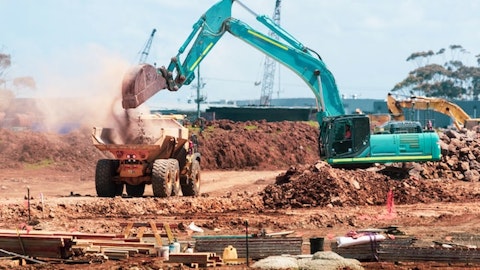And I think as Sam mentioned in his opening comments, as part of our underroof upgrades, we also identified an ability to bring on a fairly significant amount of additional capacity at a very low cost per megawatt. So going forward, we are executing that now that the centers will reach full utilization, and we’re going to add capacity in the coming years to meet the demand that we see in the market. So it’s been a real turnaround in the business.
Operator: And our next question comes from the line of Robert Hope from Scotiabank. Your question, please.
Robert Hope: HI. Good morning. Just given the markets focus on funding liquidity across a variety of sectors, how do you think about your existing liquidity position? And could you accelerate asset sales to further bolster the balance sheet or look for other levers like marketable security sales?
David Krant: Hey, Robert, it’s David here. Look I think, first and foremost, we feel very good about our current liquidity position, as you’ll see it. It’s over $2 billion at the corporate level, and a lot of the existing liquidity in each of our businesses so that they can fund a lot of the organic growth that we talked about as you’ve seen throughout our materials. I think from a liquidity perspective, I think the $2 billion of asset sales that we have earmarked for next year, is a very actionable plans you heard from Sam. We also have many pockets in the business where we think we can find additional liquidity if we need to accelerate our new investment opportunity. But when you pro forma that with 4 billion of total liquidity, we think that’s a significant amount to be operating at in this environment and going forward.
Robert Hope: Thanks for that. And then, maybe just going back to the commentary on pacing, like when we take a look at the environment, which could be full of opportunities, how is that balanced with a market where it could be more difficult to sell assets or your unit price implies a higher cost of capital. How do you balance the potential for significant accretive acquisitions versus what we call your higher cost of capital as well as a little bit higher cost of capital?
Sam Pollock: Rob, I guess all I can say is that we just closely monitor our liquidity. So we know what we have to live with as far as our capacity. And once we have visibility on our capital recycling program that will gauge our aggressiveness in pursuing big opportunities. In the meantime, we’ll continue to look at the tuck-in acquisitions or the businesses, the opportunities like this Cyxtera opportunity, which didn’t really require any capital. And we’ll take advantage of those. That there’s lots of things we can do to create value in our businesses that doesn’t require a lot of capital. And those larger ones, as we said, will match up with the cash that comes in from rest of sales.
Operator: And our next question comes from the line of Robert Catellier from CIBC Capital Markets. Your question, please.
Robert Catellier: Hey, good morning, and thank you for your comments. So far, I do want to get back to the capital allocation subject, it looks like you’ve become considerably more active under the NCIB, following quarter end. I’m just wondering if there’s something more substantial that you can do there over time. And you’ve touched on this versus comparing repurchases versus investments, but I’m wondering how you’re looking at this capital allocation in terms of some of your other options, like perhaps the deleveraging, to skip, and that seems to be what the market is focused on in general.
Sam Pollock: Hi, Robert. So you had a couple of different elements to your question there. I think just to repeat from the buyback of shares, we will do that on a periodic basis with the existing programs that we have in place, and to the extent that once we’ve done some capital recycling, we may do something larger, as opposed to making investments in new transactions. So I think that’s all we’re telling people is, it’s part of our investment decision framework today, given where we’re trading. In relation to delevering, we feel very comfortable with our balance sheet today, which has been strong and our maturities are as well laddered, as they probably have ever been, we really don’t have any maturities at the corporate level for many years.



